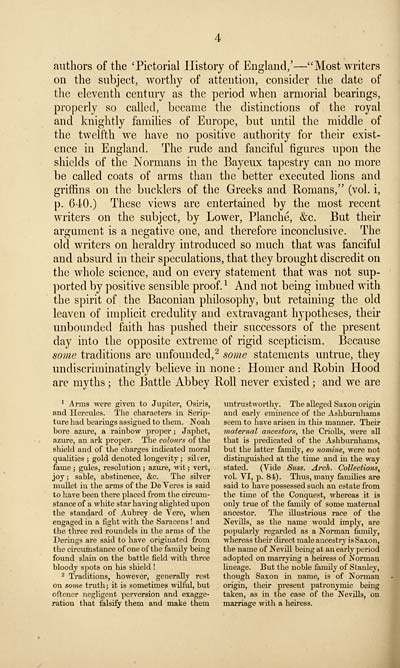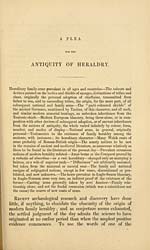Notices of the Ellises of England, Scotland, and Ireland, from the conquest to the present time
(344) Page 340
Download files
Complete book:
Individual page:
Thumbnail gallery: Grid view | List view

authors of the 'Pictorial History of England,' — "Most writers
on the subject, worthy of attention, consider the date of
the eleventh century as the period when armorial bearings,
properly so called, became the distinctions of the royal
and knightly families of Europe, but until the middle of
the twelfth we have no positive authority for their exist-
ence in England. The rude and fanciful figures upon the
shields of the Normans in the Bayeux tapestry can no more
be called coats of arms than the better executed lions and
griffins on the bucklers of the Greeks and Romans," (vol. i,
p. 640.) These views are entertained by the most recent
writers on the subject, by Lower, Planche, &c. But their
argument is a negative one, and therefore inconclusive. The
old writers on heraldry introduced so much that was fanciful
and absurd in their speculations, that they brought discredit on
the whole science, and on every statement that was not sup-
ported by positive sensible proof. l And not being imbued with
the spirit of the Baconian philosophy, but retaining the old
leaven of implicit credulity and extravagant hypotheses, their
unbounded faith has pushed their successors of the present
day into the opposite extreme of rigid scepticism. Because
some traditions are unfounded, 2 some statements untrue, they
undiscriminatingly believe in none : Homer and Robin Hood
are myths ; the Battle Abbey Roll never existed ; and we are
1 Arms were given to Jupiter, Osiris,
and Hercules. The characters in Scrip-
ture had bearings assigned to them. Noah
bore azure, a rainbow proper ; Japhet,
azure, an ark proper. The colours of the
shield and of the charges indicated moral
qualities ; gold denoted longevity ; silver,
fame ; gules, resolution ; azure, wit ; vert,
joy ; sable, abstinence, &c. The silver
mullet in the arms of the De Veres is said
to have been there placed from the circum-
stance of a white star having alighted upon
the standard of Aubrey de Vere, when
engaged in a fight with the Saracens ! and
the three red roundels in the arms of the
Derings are said to have originated from
the circumstance of one of the family being
found slain on the battle field with three
bloody spots on his shield !
2 Traditions, however, generally rest
on some truth; it is sometimes wilful, but
oftener negligent perversion and exagge-
ration that falsify them and make them
untrustworthy. The alleged Saxon origin
and early eminence of the Ashburnhams
seem to have arisen in this manner. Their
maternal ancestors, the Criolls, were all
that is predicated of the Ashburnhams,
but the latter family, eo nomine, were not
distinguished at the time and in the way
stated. (Vide Suss. Arch. Collections,
vol. VI, p. 84). Thus, many families are
said to have possessed such an estate from
the time of the Conquest, whereas it is
only true of the family of some maternal
ancestor. The illustrious race of the
Nevills, as the name would imply, are
popularly regarded as a Norman family,
whereas their direct male ancestry is Saxon,
the name of Nevill being at an early period
adopted on marrying a heiress of Norman
lineage. But the noble family of Stanley,
though Saxon in name, is of Norman
origin, their present patronymic being
taken, as hi the case of the Nevills, on
marriage witli a heiress.
on the subject, worthy of attention, consider the date of
the eleventh century as the period when armorial bearings,
properly so called, became the distinctions of the royal
and knightly families of Europe, but until the middle of
the twelfth we have no positive authority for their exist-
ence in England. The rude and fanciful figures upon the
shields of the Normans in the Bayeux tapestry can no more
be called coats of arms than the better executed lions and
griffins on the bucklers of the Greeks and Romans," (vol. i,
p. 640.) These views are entertained by the most recent
writers on the subject, by Lower, Planche, &c. But their
argument is a negative one, and therefore inconclusive. The
old writers on heraldry introduced so much that was fanciful
and absurd in their speculations, that they brought discredit on
the whole science, and on every statement that was not sup-
ported by positive sensible proof. l And not being imbued with
the spirit of the Baconian philosophy, but retaining the old
leaven of implicit credulity and extravagant hypotheses, their
unbounded faith has pushed their successors of the present
day into the opposite extreme of rigid scepticism. Because
some traditions are unfounded, 2 some statements untrue, they
undiscriminatingly believe in none : Homer and Robin Hood
are myths ; the Battle Abbey Roll never existed ; and we are
1 Arms were given to Jupiter, Osiris,
and Hercules. The characters in Scrip-
ture had bearings assigned to them. Noah
bore azure, a rainbow proper ; Japhet,
azure, an ark proper. The colours of the
shield and of the charges indicated moral
qualities ; gold denoted longevity ; silver,
fame ; gules, resolution ; azure, wit ; vert,
joy ; sable, abstinence, &c. The silver
mullet in the arms of the De Veres is said
to have been there placed from the circum-
stance of a white star having alighted upon
the standard of Aubrey de Vere, when
engaged in a fight with the Saracens ! and
the three red roundels in the arms of the
Derings are said to have originated from
the circumstance of one of the family being
found slain on the battle field with three
bloody spots on his shield !
2 Traditions, however, generally rest
on some truth; it is sometimes wilful, but
oftener negligent perversion and exagge-
ration that falsify them and make them
untrustworthy. The alleged Saxon origin
and early eminence of the Ashburnhams
seem to have arisen in this manner. Their
maternal ancestors, the Criolls, were all
that is predicated of the Ashburnhams,
but the latter family, eo nomine, were not
distinguished at the time and in the way
stated. (Vide Suss. Arch. Collections,
vol. VI, p. 84). Thus, many families are
said to have possessed such an estate from
the time of the Conquest, whereas it is
only true of the family of some maternal
ancestor. The illustrious race of the
Nevills, as the name would imply, are
popularly regarded as a Norman family,
whereas their direct male ancestry is Saxon,
the name of Nevill being at an early period
adopted on marrying a heiress of Norman
lineage. But the noble family of Stanley,
though Saxon in name, is of Norman
origin, their present patronymic being
taken, as hi the case of the Nevills, on
marriage witli a heiress.
Set display mode to:
![]() Universal Viewer |
Universal Viewer | ![]() Mirador |
Large image | Transcription
Mirador |
Large image | Transcription
Images and transcriptions on this page, including medium image downloads, may be used under the Creative Commons Attribution 4.0 International Licence unless otherwise stated. ![]()
| Histories of Scottish families > Notices of the Ellises of England, Scotland, and Ireland, from the conquest to the present time > (344) Page 340 |
|---|
| Permanent URL | https://digital.nls.uk/95549741 |
|---|
| Description | A selection of almost 400 printed items relating to the history of Scottish families, mostly dating from the 19th and early 20th centuries. Includes memoirs, genealogies and clan histories, with a few produced by emigrant families. The earliest family history goes back to AD 916. |
|---|

